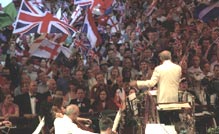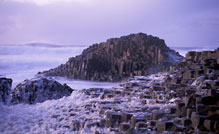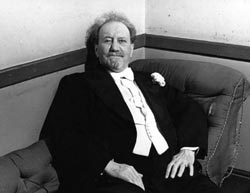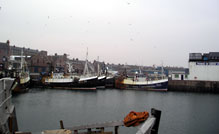

When we imagine the coast, what sounds are evoked in our minds?
Maybe we think of the sounds of nature: the rhythmic swash and backwash of the waves, or heavy rollers crashing on the rocks; the sound of seabirds as they swoop and dive for food or jostle for nesting space on a cliff; or perhaps it is the sound of the wind stirring the reeds and grasses along the banks of a sheltered estuary. Alternately, we may imagine sounds which evoke a human presence: fog horns in the channel; the compulsive chinking of rigging against mast; children playing; Punch and Judy, or the brash cacophony of amusement arcades.
Whichever of these, and a host of other sounds, are brought to mind we clearly imagine the sounds of the seaside in a variety of ways. In turn this reflects our manifold uses and encounters with the coast and the ways in which these are invested with cultural meaning encapsulating our hopes, fears and memories.

As a cultural symbol and a physical presence, the coast is a solid defence against threat and itself a precious natural system in danger of inundation, transformation and loss. It is a place of work, a giver and taker of lives and livelihoods. At the same time, it is a zone of leisure and pleasure, innocent pastimes, robust healthy exercise, over-indulgence and covert assignations. In each of these ways and more the sounds of the seaside are deeply engrained in our cultural consciousness. Music plays a fundamental role energising these imaginings. From the reassuring strains of Sailing By accompanying the BBC Radio 4 shipping forecast, to the ribald lyrics of George Formby; and from the majestic grandeur of Mendelssohn's Hebridian Overture to the pulsating compulsion of the Ibiza sound, the coast is imagined for us in music. Thus music reflects the many ways in which we imagine the British Isles and the experience of living in them.
The sea and the coast have been important themes in the history of British classical music since the revival, known as the British musical renaissance, led by composers such as Sir Hubert Parry (1848-1918) and Charles Villiers Stanford (1852-1924) in the 1880s. Not surprisingly a major theme in these works has been the patriotic invocation of Britain as a seafaring nation.
Some of the most popular and accessible works by British composers fall into this category. C. V. Stanford's Five Songs from the Sea (1904) to words by Sir Henry Newbolt (for example the songs Drakes Drum and The Old Superb) conjure up a nostalgic picture of a great age of English seafaring triumph using appropriately strong, forthright and rumbustious melodies. In contrast, John Ireland's setting of John Masefield's Sea Fever (1913) is an elegiac celebration of the freedom of the open sea drawing on a romantic idealisation of the seafaring life central to ideas of British identity.

William Walton's (1902-1983) overture Portsmouth Point, written in 1925, also invokes a romanticised history of Britain as a great sea power. Walton drew inspiration from a print by the English caricaturist Thomas Rowlandson (1756-1827). Rowlandson's picture shows the waterfront at Portsmouth before the departure of the fleet; a crowded picture of bawdy merry-making and tender parting.
However, perhaps most widely known is Henry Wood's (1869-1944) Fantasia on British Sea Songs written in 1905 as a centenary salute to Nelson's victory and death at Trafalgar. Wood was the first conductor of the Promenade concerts; indeed, now the Proms carry his name as part of their full title. This work, which sets a number of sea shanties and hornpipes in an arrangement for orchestra and soloists, has become an institution at the Last Night of the Proms. It has remained a focus for the celebration of Britishness, even though this has come under increasing criticism as a jingoistic anachronism in recent years.

Rather than suggest a confident assertion of Britishness, music reflecting the place of Britain as a seafaring nation has often expressed doubt concerning Britain's role in the world, at once acknowledging its maritime heritage and questioning what that means for being British. A Sea Symphony by Ralph Vaughan Williams (1872-1958) is a case in point.
First performed at the Leeds Festival in 1910, it is a work for orchestra, chorus, soprano and baritone soloists. Written in such a way as to appeal to the very extensive market for sacred oratorios which developed in Britain during Victorian times, the work has a grand opening statement depicting the vast expanses of the mighty ocean rhythmically mimicking the movement of the sea. This is followed by a celebration "[o]f unnamed heroes in the ships…" set to music adopting the robust qualities of a sea shanty.
It would be very easy to see this work as merely another expression of imperialist excess; however, this is very far from the case. In spite of his privileged background Vaughan Williams had distinctly socialist and antiwar sympathies (during WWI he worked for the Ambulance Corps in France). A Sea Symphony sets words by Walt Whitman which are distinctly humanistic and ecumenical. The work is a hymn to all humanity in which the sea represents the vastness of the universe; and the sailor, a journey into true faith made by each humble individual.
The limitless power of physical nature suggested by A Sea Symphony forms another important focus as British composers depicted the grandeur of rocky coastlines and the struggle of humans against the sea whilst telling a variety of stories about Britain and Britishness. In Arnold Bax's (1883-1953) orchestral tone poem Tintagel (1917-19) the composer claimed the music was designed to conjure a vision of the cliff on which stood the fabled castle. Here Bax uses the power of nature to evoke a majestic and mythologised Anglo-Celtic history.
Bax explains: "in the middle section it may be imagined that with the increasing tumult of the sea arise memories of the historical and legendary associations of the place, especially those connected with King Arthur, King Mark and Tristan and Iseult." The Garden of Fand, (1913-16) Bax's symphonic poem about Irish sailors venturing out upon the ocean to be seduced by an enchanted island, also relates Celtic myth to the power of the sea. The work is a ghostly invocation of the hero Cuchulain under the spell of the abandoned wife of the god of the ocean.
Like Bax, Vaughan Williams draws on an Irish example to portray the sea as a cruelly dispassionate arbiter of human fate. Riders to the Sea (1937) set to J. M. Synge's portrayal of an Irishwoman's loss of her sons to the ocean, one after the other, is often thought of as Vaughan Williams' most successful opera. It uses the sea as a cauldron from which the orchestra boils up, threatening to overwhelm the singers just as the sea threatens to engulf the family in the story. It is a tale of stoic resignation in the face of implacable nature and of fate. By contrast, in his Norfork Rhapsody No. 1 (1906- revised 1914) Vaughan Williams portrays coastal landscapes with an imperturbable serenity.
Opening with orchestral sounds echoing the bird song of marsh and fen, the work develops broad folk song based melody interweaving three sea shanties collected by Vaughan Williams at Great Yarmouth on the Norfolk coast. After a lively interlude based on sea shanties, which seems to celebrate the fishing community of Yarmouth, the work returns to its tranquil and ethereal opening. In this soundworld the coastal landscape of Norfolk exists as a harmonious idyll of fen and fishing communities set within broad melancholy expanses of sea and sky.
Yet portrayals of peaceful coastal communities are relatively rare in British music. More frequently fishing communities have been the setting for stories of oppression, prejudice and intrigue. Dame Ethyl Smyth's (1858-1944) opera The Wreckers (1906) is set in Cornwall in the mid 18th century. The plot concerns a poor isolated community and the tragic struggle of two of its members to escape the oppressive values which threaten their love for each other. At the end of the work the lovers are left to die together in a cave as the rising tide engulfs them. More recently Peter Maxwell Davis's (b.1934) chamber opera The Lighthouse (1980) is based on the unexplained desertion of the Flannen Isles lighthouse in 1900. For the lighthouse keepers it is a tale of isolation and hysteria in which brutality, loss and guilt emerge from their pasts and come back to haunt them.

Also notable are the operas of Benjamin Britten (1913-1976) and particularly his first full opera Peter Grimes (1945). Set in a small fishing community evoking Aldeburgh and the Suffolk coast, the opera tells of the struggles of the fisherman, Peter Grimes, against the townspeople of the Borough, the death of his two boy apprentices and the blame thrust upon him by a close knit community.
After Grimes disobeys the court's orders by getting another apprentice, who is treated roughly and accidentally slips off a cliff, Grimes is persuaded to sail out to sea and drown himself. Though in the poet George Crabbe's original version Grimes is represented as essentially evil, Britten reworks this to show him as an ambiguous character with both harsh and tender sides to his personality. It is sometimes thought that this dramatic contrast between a non-conformist outsider who ultimately desires acceptance, and a censorious and bigoted community who refuse to understand, reflects eloquently on the acceptability of Britten's own sexuality.
Musically Peter Grimes adopts many key motifs used in music to depict Britain's coastal landscapes: crying seagulls, the movement of waves, the power of a rising storm, sea shanty-like melodic writing; landmark sounds of church and fog horn signify heroism and the perils of life at sea. These motifs return time and again, even amongst the complex and abstract work of contemporary composers. Peter Maxwell Davis, for instance, has found both formal and emotional reconciliation between materials depicting the lives of fishing and crofting communities in the Orkney Isles where he now lives, and a compositional style combining classical structures with forms derived from mathematics and number symbolism.
The orchestral work Lighthouses of England and Wales by Benedict Mason (b. 1955), which won first prize in the 1988 Benjamin Britten Composers Competition, works with sounds made by the sonic beacons used by ships to locate specific lighthouses. The work derives from a journey, in which the composer visited lighthouses between the Solway Firth and the Farne Islands, carefully documenting the exact frequencies of their signals.
In an almost impressionistic piece, he portrays individual beacons, but also opposes different signals in complex rhythms of interference. Here conventional associations of the lighthouse with an ethos protection as a guide and comfort to the traveller are fused with dispassionate documentation. Mason takes us on a journey round a hidden coastal landscape of sound which is abstract and impersonal yet descriptive and place specific.
In this brief tour, we have heard the coast as a repository for a wide variety of national imaginings, Elizabethan forthrightness, Georgian exuberance, Victorian certainty, and Celtic mysticism. It encapsulates the heroism, practicality, duty and service of British citizens represented as 'an island race'.
However, the coast is always ambiguous and ambivalent in its cultural meanings. Represented in sound it is a symbol of pride and national achievement though it is also a focus for melancholy and self doubt. It celebrates the heroism of seafaring communities and exposes fallibility and human frailty.
The coast harbours prejudice and constraint, and it provides a jetty from which to launch journeys of individual and spiritual freedom.
Rate and Review
Rate this article
Review this article
Log into OpenLearn to leave reviews and join in the conversation.
Article reviews